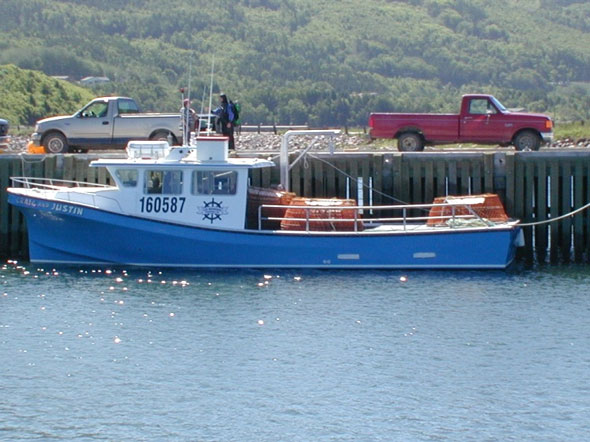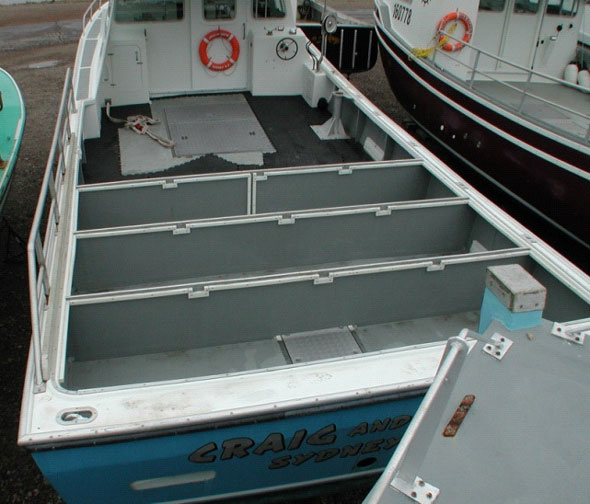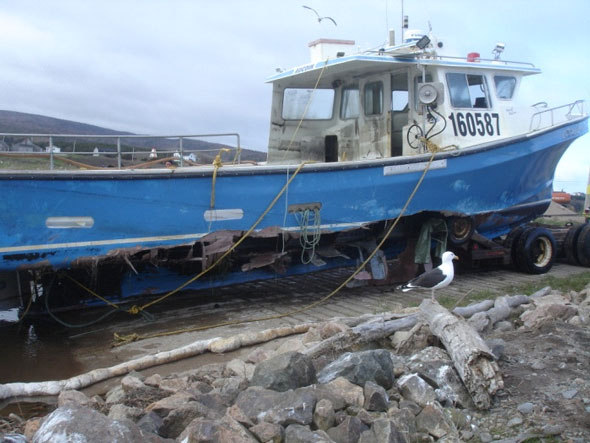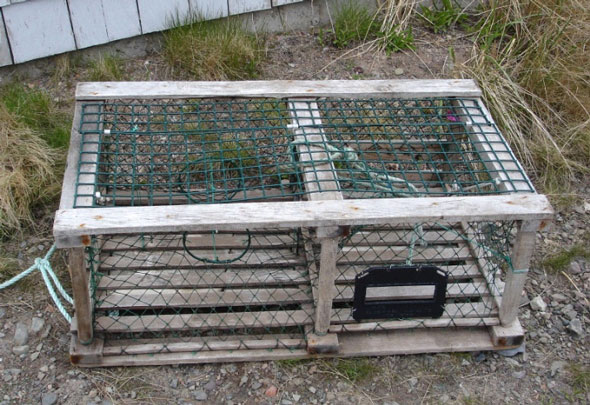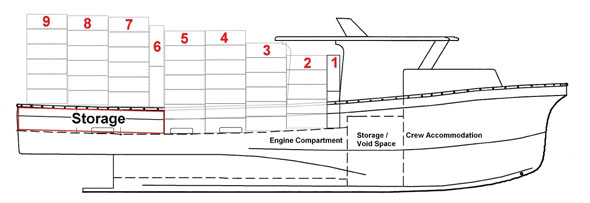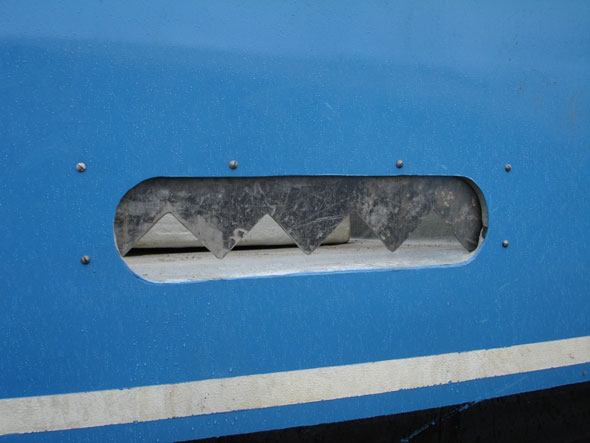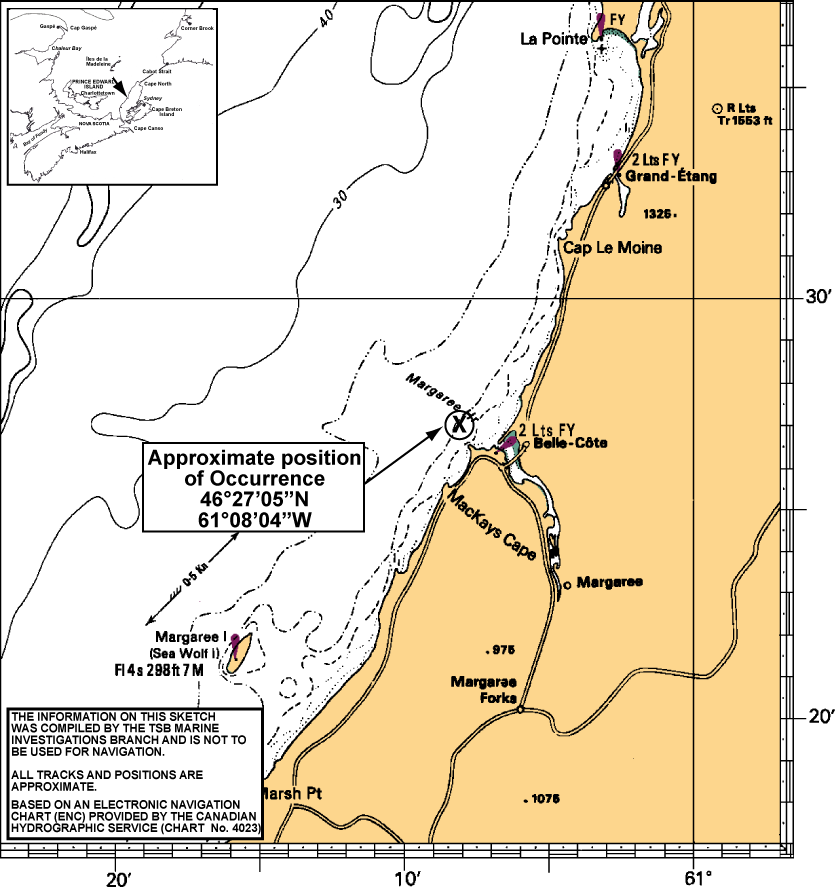Capsizing and sinking
Small fishing vessel Craig and Justin
Off Margaree Harbour, Nova Scotia
The Transportation Safety Board of Canada (TSB) investigated this occurrence for the purpose of advancing transportation safety. It is not the function of the Board to assign fault or determine civil or criminal liability. This report is not created for use in the context of legal, disciplinary or other proceedings. See Ownership and use of content. Masculine pronouns and position titles may be used to signify all genders to comply with the Canadian Transportation Accident Investigation and Safety Board Act (S.C. 1989, c. 3).
Summary
On the morning of 01 May 2010, at 0615, Atlantic Daylight Time, the small fishing vessel Craig and Justin, with a crew of 4 on board, capsized and sank approximately 1 nautical mile west-northwest of Margaree Harbour, Nova Scotia. Three crew members were quickly recovered from the water by nearby fishing vessels. One crew member drowned.
Factual information
Particulars of the vessel
| Name of vessel | Craig and Justin |
|---|---|
| Official number | 826789 |
| Port of registry | Sydney, Nova Scotia |
| Flag | Canada |
| Type | Small fishing vessel |
| Gross tonnage | 14.63 |
| Registered LengthFootnote 1 | 11.72 m |
| Built | 2003, Hardwick, New Brunswick |
| Propulsion | One diesel engine (321 kW) driving a single fixed-pitch propeller through a reversible reduction gearbox. |
| Crew | 4 |
| Registered owner | Les Moineaux Fisheries Inc., Cheticamp, Nova Scotia |
Description of the vessel
The Craig and Justin was a Northumberland-style fishing vessel used for crab and lobster fishing. The wheelhouse and accommodation was forward, with the engine compartment beneath the watertight working deck. Entry to the wheelhouse was through a door on the starboard side. Access to the engine compartment was through a hatch located on the working deck.
The glass-reinforced, plastic hull below the working deck was subdivided by 2 transverse bulkheads that enclosed, from forward, the crew accommodation space, a storage/void space and the engine compartment (see Appendix A).
Two diesel tanks were fitted on the port and starboard sides of the engine compartment at the stern. A fresh water tank was located in the fore part of the vessel. Two automatically activated, submersible bilge pumps were fitted in the engine compartment. The bilges could also be pumped through the remotely activated engine driven general service pump. The vessel was fitted with a bilge flooding alarm system.
The working deck was watertight and surrounded by a solid bulwark, forming a well. The bulwark was fitted with 2 freeing ports in the port side, 3 in the starboard side, and 2 in the transom. Shortly following delivery in 2003, all the freeing ports were fitted with vertical slider plates that could completely cover the opening, with the exception of a small gap at the bottom. In 2008, the slider plates on the forward freeing port of each side were replaced by a fixed plate with a saw-tooth design cut on the lower edge that reduced the freeing area by about half (see Appendix B). The engine exhaust duct opening was located along the centreline of the transom below the freeing ports. The arrangement of the exhaust duct prevented water from flooding the engine when its opening was submerged.
The working deck was fitted with 3 transverse pound boards to create storage areas (see Photo 2). Small holes were cut into the transverse pound boards, which allowed water to flow between the areas. The pound boards were fitted with portable covers, extending to the transom, on which the traps and gear could be stowed.
Many Northumberland-style fishing vessels are built as undecked vessels, with buoyancy largely determined by the watertight hull to the full height of the gunwales. The Craig and Justin, however, was built as a decked vessel. As such, the incorporation of the watertight working deck and the addition of freeing ports at deck level resulted in a vessel where buoyancy and stability were largely determined by underdeck flotation, plus the location of the freeing ports and their ability to clear water shipped on deck. The Craig and Justin was fitted with navigation and electronic equipment typically found on most modern small fishing vessels, including a very high frequency (VHF) radiotelephone with digital selective calling capability.Footnote 2
History of the voyage
On 30 April 2010, the crew of the Craig and Justin loaded lobster traps onto the vessel in preparation for the start of the lobster season the following day. The maximum number of traps carried in the past had been 225, but as the weather and sea conditions for the following day were favourable, 275 trapsFootnote 3 were loaded onboard the vessel (see Appendix A). The vessel had a small list to port, was trimmed by the stern, and about half of the exhaust duct opening at the transom was underwater. The slider plates on the 5 aftermost freeing ports were closed.
At 0600,Footnote 4 on 01 May 2010, the vessel, with a masterFootnote 5 and 3 crew members onboard, departed Margaree Harbour, Nova Scotia, for the lobster fishing grounds, approximately 1 nautical mile to the west-northwest. None of the crew was wearing a life jacket or immersion suit. At about 0605, the crew laid the first string of 5 traps, starting with the traps nearest the stern. Initially, 2 crew members stood on the gunwales aft, setting the traps until a space on deck was cleared. After setting the first string, the vessel proceeded slowly to the next location. A few minutes later, the vessel was slowly altering course to port in preparation to lay the next string when it heeled suddenly to port. As the heel continued to increase, the master attempted to broadcast a distress call on the VHF radiotelephone, but was only able to transmit the word "Mayday"
several times before the vessel capsized at 0615. The crew members ended up in the water wearing only light clothing; however, 2 of them managed to cling to the hull. The liferaft remained lashed to its cradle on top of the wheelhouse.
The Craig and Justin's overturned hull was visible to several fishing vessels in the vicinity that had also received the master's distress message. Approximately 7 minutes after the capsize, these vessels arrived on scene to rescue the crew. Three survivors were recovered. The fourth crew member, who had initially clung to the hull, was found to have drowned. The survivors were treated for cold water immersion at a nearby hospital.
The vessel later sunk in approximate position 46°27′05″ N, 061°08′04″ W (see Appendix C).
Damage to Vessel
The vessel was subsequently salvaged, but the hull had been extensively damaged on the starboard side and was declared a total loss (see Photo 3).
Environmental impact
There was a release of pollutants, but they quickly dissipated through evaporation and wind/wave action.
Vessel certification
As a small fishing vessel not exceeding 15 tons, gross tonnage, the Craig and Justin was not required by regulation to be inspected by Transport Canada (TC), nor had it been. Furthermore, the vessel was not required to submit stability data for approval and had not done so.
Personnel certification
The master of the Craig and Justin held a Fishing Master III certificate since 1995, as well as a Marine Emergency Duties certificate. He had 25 years of experience fishing and had been the master for the Craig and Justin since it was acquired as a new build in 2003.
Two crew members had fishing experience: one was a retired fisherman with more than 40 years' experience while the other had 8 years. The third crew member had no fishing experience and was onboard for this trip only. None of the 3 crew members had marine emergency duties training, nor was this required by regulation.Footnote 6
Weather
Weather at the time of the occurrence consisted of light airs from the south, calm seas, an air temperature of 2.9° C and unlimited visibility. The water temperature was about 1°C or 2°C.
Lifesaving equipment
Lifesaving equipment aboard Craig and Justin included 4 lifejackets (stowed in the accommodations), one 4-person liferaft and 1 lifebuoy. The liferaft was secured on top of the wheelhouse with a lashing that was fitted with a senhouse slip. The liferaft's painter was not attached to a fixed point on the vessel.
After the accident, the TSB conducted a review of 73 small fishing vessels in the Chéticamp, Margaree Harbour and Inverness areas of Nova Scotia to examine the securing arrangements of liferafts. The review found that of the 40 vessels that had a liferaft on board, 23 liferafts were not secured using a float-free arrangement. The remaining 17 liferafts were fitted with a hydrostatic release unit, but only 10 were fitted correctly.
Loading of Vessel
When the vessel departed port, the 275 lobster traps were stacked in 9 tiers of varying heights. The foremost 5 tiers were placed directly on deck, and the last 4 tiers were on top of the pound board covers (see Appendix A).
The lobster traps each weighed about 33 kg and the total weight of the traps was approximately 9.08 tonnes. The weight of the ropes for the traps was approximately 0.36 tonnes.
The fuel tanks were full and each contained about 0.56 tonnes of diesel. The fresh water tank was empty.
Vessel Buoyancy and Stability
Following the occurrence, the TSB carried out a lightweight survey and an inclining test on a vessel similar to the Craig and Justin. Taking into consideration the minor differences between the 2 vessels, the lightship displacement and centre of gravity of the Craig and Justin were determined. A computer model of the vessel's hull was also prepared by taking measurements from its port side, which remained intact following the occurrence, and calculations were performed to assess the stability of the Craig and Justin around the time of the occurrence.
The calculations were consistent with the Craig and Justin's loaded condition at the time of departure. Considering the small freeboard and that the 5 aftermost freeing ports were essentially blocked off, further calculations were performed to examine the effect of water being trapped in the deck well by the bulwark.Footnote 7 These calculation results are summarized in Table 1 below:
| Condition | Trim Aft (m) |
Heel to Port (degree) |
Freeboard to Lower Edge of Freeing Ports on Port Side (mm)Footnote 8 | Minimum Freeboard to Top of Bulwark (mm) | Notes | |
|---|---|---|---|---|---|---|
| Fwd | Aft | |||||
| Departure with 225 traps |
0.72 | 0.33 | 95 | 82 | 698 | Previous maximum loading; lower edge of exhaust immersed by 100 mm |
| Occurrence Departure with 275 traps | 0.77 | 0.52 | 43 | 20 | 640 | Lower edge of exhaust immersed by 162 mm |
| + 1% water trapped in wellFootnote 9 | 0.80 | 0.98 | 18 | -8 | 610 | Port, aft freeing port immersed |
| + 5% water trapped in well | 0.89 | 2.24 | -59 | -99 | 518 | All freeing ports on port side immersed |
| + 25% water trapped in well | 1.26 | 10.25 | -484 | -577 | 6 | Aft bulwark immersed |
Vessel Modifications
TC encourages owners and masters of fishing vessels of under 15 tons, gross tonnage, to maintain a record of modifications and to solicit the assistance of a marine consultant if these modifications will result in a substantive change to the safety and stability of the vessel.Footnote 10 When the owner of the Craig and Justin modified the freeing ports in 2008, this was not done.
Stability Standards for Small Fishing Vessels
Decked Versus Undecked Vessels
The ability of a vessel to remain afloat and upright in all loading and operating conditions is fundamental to safety. Thus, it is essential that the vessel provide sufficient reserve buoyancy and stability, and prevent the entry and accumulation of water on deck or into the hull. Freeboard, sufficient downflooding height and adequate drainage must also be maintained. To ensure safety as sea, these factors must be taken into consideration when designing, constructing and operating decked and undecked vessels.
For a decked vessel, buoyancy and stability are mainly provided by the volume of the watertight hull below the deck.Footnote 11 When that deck is surrounded by a bulwark, thereby forming a well, the size, number and location of openings in the bulwark, or freeing ports, should be sufficient to drain water freely and quickly overboard to avoid free surface effect. Reserve buoyancy and stability are a function of the freeboard measured to the position of the lowest downflooding point. Reducing the freeboard or the height of the downflooding point, therefore, reduces reserve buoyancy and stability as well as lowers the margin of safety.
For an undecked vessel, buoyancy and stability is provided by the watertight hull, which extends to the top of the gunwale. This type of vessel is vulnerable to swamping by water coming over the sides, a risk that may be mitigated by limiting operations to relatively calm waters, incorporating built-in flotation to improve survivability, and providing means to efficiently remove any water that would be shipped over the side. As with decked boats, reducing the freeboard or the height of the downflooding point reduces the reserve buoyancy and stability as well as lowers the margin of safety.
Many Northumberland-style fishing vessels feature a solid bulwark/gunwale with small drains or scuppers for clearing water from the working deck and, for this reason, fall under the definition of an undecked vessel. Although the Craig and Justin's hull form was otherwise similar to these vessels, because it had a watertight deck fitted with a solid bulwark, incorporating freeing ports,Footnote 12 itpossessed the attributes of a decked vessel. Accordingly, when the Craig and Justin was registered in 2004, the vessel type was described as “fishing/decked”, the tonnage depth was measured up to the working deck level, and the gross tonnage was determined to be 14.63.
Canadian Standards
Currently, in Canada, there are no specific standards or regulatory requirements governing the draught and freeboard to which small fishing vessels less than 15 tons, gross tonnage, such as the Craig and Justin, may be safely laden with fish or gear. Consequently, such fishing vessels have no load lines or load-to lines, and their loading is left to the judgement of the operators.
International Maritime Organization
In June 2010, the International Maritime Organization's (IMO) Maritime Safety Committee (MSC) issued safety recommendations intended to apply to new decked fishing vessels of less than 12 m in length and new undecked fishing vessels.Footnote 13 These recommendations included standards for stability assessment. The stability of the Craig and Justin in its port departure condition, was assessed against these standards—for both its actual configuration as a decked vessel, and also for an assumed configuration as an undecked vessel. The results of this assessment, which are summarized in Table 2, indicate that as a decked vessel carrying 275 traps, it did not meet all of the stability criteria and that it could only carry a maximum of 171 traps. If it had been considered an undecked vessel meeting all criteria, it could have carried a maximum of 275 traps.
| Description of CriteriaFootnote 14 | Craig and Justin Loaded with 275 Traps and 95% Fuel |
|||
|---|---|---|---|---|
| As Decked VesselFootnote 15 | As Un-Decked Vessel | |||
| Required | Actual | Required | Actual | |
| Initial metacentric height (GM) (m) | 0.35 | 1.70 | 0.35 | 1.70 |
| Righting arm at 30˚ (m) | 0.20 | -0.13 | n/a | n/a |
| Area under righting arm curve to 30˚ or downflooding (m-radians) | 0.055 | 0.004 | n/a | n/a |
| Area under righting arm curve from 30˚ to 40˚ or downflooding (m-radians) | 0.090 | -0.034 | n/a | n/a |
| Area under righting arm curve to 40˚ or downflooding (m-radians) | 0.030 | -0.031 | n/a | n/a |
| The fitting of acceptable buoyancy compartments, distributed so the vessel will stay afloat on an even keel if flooded | n/a | n/a | Buoyancy compartments fitted so the vessel will stay afloat on an even keel if flooded | Not tested |
| Maximum number of traps if all criteria are met | 171 | 275 | ||
Fishing Vessel Safety
On 16 March 2010, the Board released its Watchlist, identifying 9 critical safety issues investigated by the TSB that pose the greatest risks to Canadians, one of which was the loss of life on fishing vessels. With an average of 12 fatalities per year between 2005 and 2009, the Board remains concerned about vessel modifications and their impact on stability; the use and availability of lifesaving equipment; regulatory oversight; the impact of fishing resource management plans and practices; as well as the lack of both a safety culture and a code of best practices. The Watchlist also highlighted the need for the industry to adopt and promote safe operating procedures and practices to increase the safety knowledge of fishing vessel operators.
Analysis
Vessel Capsizing
The reserve buoyancy and stability of the Craig and Justin during its final voyage was affected by many factors. First, the combined weight of the 275 traps, ropes and fuel on board was such that the vessel was heavily loaded with a list to port, and the freeboard and reserve buoyancy were therefore minimal. Moreover, the storage of the traps on the working deck and high on top of the pound board covers created a trim by the stern and a high centre of gravity, which further reduced the stability of the vessel.
Although the weather and sea conditions were forecasted to be favourable, the small freeboard would have been ineffective at preventing the entry of water on deck via the freeing ports as a result of encounters with natural waves or the motions of the vessel. As such, the 2 forward-most freeing ports, which had not been fully blocked off, would have allowed water to enter the deck well as the vessel manoeuvred along. This water would then have been able to drain aft, through the drain holes in the transverse pound boards, and would have been trapped in the well because the other freeing ports had been effectively blocked by the slider plates.
The accumulation of water on deck would not have been visible to the crew due to the traps and pound board covers and, according to the results of the stability assessment, only a small amount of water would have been sufficient to submerge the deck and the freeing ports. Once at this point, the vessel would have been in a progressive state of flooding in the deck well until it lost all stability and capsized.
Fitness for Purpose
When the Craig and Justin departed port on the day of the occurrence, it was loaded with approximately 50 more traps than the maximum of 225 that had been carried in the past. The results of the stability assessment indicate that the freeboard of the vessel, with a load of 225 traps, was minimal and was further reduced by the additional 50 traps (see Table 3 below).
| Number of Traps | Average Freeboard to Working Deck | |
|---|---|---|
| Previous Maximum Load | 225 | 89 mm |
| Occurrence Load | 275 | 32 mm |
| Difference | 50 | 57 mm |
Table 4a and table 4b compare the number of traps loaded on the day of the occurrence with the maximum number that would have been permitted had the vessel complied with the stability standards recommended by the IMO. This comparison shows that, as an undecked vessel (assuming the absence of the freeing ports in the bulwark and with appropriate buoyancy compartments), the Craig and Justin would have been deemed fit for purpose in terms of its stability. In contrast, for its actual configuration as a decked vessel, the number of traps carried would have to be significantly reduced (i.e. to 171 traps) in order to meet the same standard. The Craig and Justin, as loaded, was unfit according to these standards.
| For Assumed Configuration – Undecked Vessel | Occurrence Load | Typical Load |
|---|---|---|
| Actual Number of Traps | 275 | 225 |
| Maximum Number of Traps for Stability Compliance |
275 | |
| Reduction in Traps Required for Stability Compliance |
No reduction | No reduction |
| For Actual Configuration – Decked Vessel | Occurrence Load | Typical Load |
|---|---|---|
| Actual Number of Traps | 275 | 225 |
| Maximum Number of Traps for Stability Compliance |
171 | |
| Reduction in Traps Required for Stability Compliance |
104 (38%%) | 54 (24%%) |
Vessel Modifications
Modifications to fishing vessels, which may adversely affect safety, are often carried out without an assessment by a marine consultant or a TC inspector.
In this occurrence, the 2 forward-most freeing ports of the Craig and Justin were modified after its initial delivery without conducting an evaluation of the possible safety implications. While this did not play a significant role in the occurrence, owners may not be fully aware of the safety implications of their modifications unless they are adequately assessed.
Stability Standards for Small Fishing Vessels
In this occurrence, a major contributing factor was the Craig and Justin's lack of sufficient freeboard, reserve buoyancy and stability. Furthermore, the investigation determined that, even under typical maximum load conditions, the vessel did not meet recognized IMO standards. Currently, in Canada, there is no requirement for small fishing vessels of less than 15 tons, gross tonnage, to have their stability and freeboard assessed, nor are there standards or guidance for establishing the minimum freeboard to which a fishing vessel may be safely laden with fish or gear.Footnote 16 In the absence of such standards or guidance, it is likely that fishermen will continue to unknowingly place their vessels at risk.
Liferaft
In emergency situations, securing arrangements that require human intervention can result in liferafts not being deployed if crew members can not quickly access equipment, as was the case in this occurrence. The securing arrangement for the liferaft included a quick release mechanism ― a senhouse slip ― that required manual operation in order to deploy the liferaft. However, the speed at which the vessel capsized prevented the crew members from launching the liferaft.
In cases where there can be insufficient time to manually deploy a liferaft during an emergency, especially with smaller vessels such as the Craig and Justin, it is imperative that a liferaft be secured by a lashing fitted with a hydrostatic release unit (HSU) or placed in deep chocks without lashings so that it floats free if the vessel sinks. Furthermore, the liferaft's painter must also be made fast to a weak link that is designed to part, thus preventing the liferaft from being pulled underwater.
When a liferaft is launched manually, the full length of the painter must be hauled out in order to inflate it. Deployed automatically, the full length of the painter will be pulled out as the vessel sinks and the liferaft inflates prior to the weak link parting. Automatic inflation can be achieved by fitting the liferaft with an HSU that will activate when it reaches a maximum depth of 4 m. A liferaft placed in deep chocks with a weak link would achieve the same outcome. The absence of such float-free arrangements for securing liferafts compromises the chances of survival at sea if crews do not have time to manually deploy the equipment.
Personal Flotation Devices and Thermal Protection
When small fishing vessels capsize, they tend to do so quickly. This can often prevent crew members from donning thermal protective clothing and lifejackets before abandonment. In this occurrence, the crew wore light clothing and did not have time to retrieve the lifejackets from the accommodations before they entered the cold water. As a result, the crew had no thermal protection against the cold and either struggled to keep their heads above water or clung to the overturned hull until help arrived. It is generally accepted that persons holding still and wearing a standard lifejacket and light clothing in water of 2°C or 3°C would be able to help themselves for about 15 minutes. After this period, they would become weak and unable to help themselves. The predicted survival time in water of 2°C or 3°C is a little more than 1 hour, after which the victim will likely succumb to hypothermia.
The approved life jacket required to be carried on fishing vessels must meet rigorous buoyancy standards and have the ability to turn an unconscious person in the water to a face-up position. This life jacket design does, however, make them cumbersome as work attire and can present a hazard when working with fishing gear. Conversely, personal flotation devices (PFDs) provide freedom of movement, and TC-approved versions are available on the market. PFDs should only serve as an aid to keep a person afloat in the water and are not a substitute for, nor intended to function as, a replacement for an approved life jacket. Neither lifejackets nor PFDs provide thermal protection.
Work wear that does not provide the wearer with reasonable flotation or thermal protection reduces the chances of survival in those situations where an individual may suddenly end up in the water.
Emergency Position-Indicating Radio Beacons
The need to alert authorities in a timely manner and to request assistance in the event of capsizing or foundering is crucial to ensuring that no time is lost in initiating rescue efforts.
Although not a factor in this occurrence, the Craig and Justin did not carry an emergency position-indicating radio beacon (EPIRB), nor was it required to do so by regulation. The speed at which the vessel capsized was such that the master did not have time to broadcast any information regarding the situation, other than to indicate a distress. However, had there been no vessels in the vicinity, the carriage of an EPIRB onboard would have provided an opportunity to automatically transmit an alert to search and rescue authorities at the onset of the distress (once the EPIRB reached the maximum 4 m depth that would activate the HSU and release it). Previous occurrences have indicated that the carriage of an EPIRB can contribute to the saving of lives.Footnote 17
Following the investigation into the sinking of the small fishing vessel Brier Mist,Footnote 18 the Board recommended that:
The Department of Transport require small fishing vessels engaging in coastal voyages to carry an emergency position indicating radio beacon or other appropriate equipment that floats free, automatically activates, alerts the search and rescue system, and provides position updates and homing-in capabilities.
Transportation Safety Recommendation M00-09
In response to the Board's recommendation, TC indicated that it continues to support and encourage the voluntary carriage of EPIRBs on all vessels that are not required to carry this equipment. Furthermore, a risk assessment study was completed by TC to evaluate the need for more effective distress-alerting capabilities on small commercial vessels, including fishing vessels that are not yet required to carry either an EPIRB or a VHF radio with digital selective calling. The study identified certain scenarios where the level of risk was deemed unacceptable. In March 2010, TC indicated that it may recommend additional EPIRB carriage requirements in consultations to amend the Navigation Safety Regulations as part of the regulatory reform initiative. TC's work is ongoing and no date has been set as to when amendments to the regulations will be published in the Canada Gazette, Part I. The Board has assessed TC's response as indicating Satisfactory Intent.
When a distress message cannot be transmitted and there is no means to automatically alert authorities to an emergency, valuable time may be lost in initiating the rescue effort.
Findings
Findings as to causes and contributing factors
- The vessel was loaded such that there was a high centre of gravity and insufficient freeboard to prevent the entry of water onto the working deck from encounters with waves or the motions of the vessel.
- Once a small amount of water had accumulated, the deck and the freeing ports were submerged, putting the vessel in a progressive state of flooding of the deck until it lost all stability and capsized.
Findings as to risk
- In the absence of standards or guidance regarding the minimum freeboard to which a fishing vessel can be safely laden with fish or gear, it is likely that fishermen will continue to unknowingly place their vessels at risk.
- The absence of float-free arrangements for securing liferafts compromises the chances of survival at sea if crews do not have time to manually deploy equipment.
- When a distress message cannot be transmitted and there is no means to automatically alert authorities of an emergency, valuable time may be lost in initiating rescue efforts.
- Work wear that does not provide the wearer with flotation or thermal protection reduces the chances of survival in those situations where an individual may suddenly end up in the water.
- Vessel modifications that are not adequately assessed for their safety implications may increase the risk to vessels and their crew.
Other findings
- The Craig and Justin, configured as a decked vessel and as loaded, was unfit according to recommended International Maritime Organization (IMO) stability standards.
This report concludes the Transportation Safety Board's investigation into this occurrence. Consequently, the Board authorized the release of this report on .
Appendices
Appendix A - Vessel Profile and Loading of Lobster Traps
| Tier | Column x Row | Traps |
|---|---|---|
| 1 | - | 5 |
| 2 | 6 x 5 | 30 |
| 3 | 6 x 6 | 36 |
| 4 | 6 x 7 | 42 |
| 5 | 6 x 7 | 42 |
| 6 | 6 x 2 | 12 |
| 7 | 6 x 6 | 36 |
| 8 | 6 x 6 | 36 |
| 9 | 6 x 6 | 36 |
| Total | 275 |
